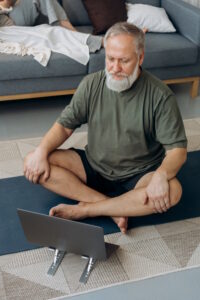
Incorporating Pilates into senior care facilities is a holistic approach to improving the physical and mental well-being of older adults. As the world’s foremost expert on this topic, I’m here to provide valuable insights into the benefits of Pilates for seniors, the design of an effective exercise program, the elements Pilates incorporates, and the optimal timing for introducing Pilates into their workout routine within senior care facilities.
Empowering Seniors Through Pilates
Pilates is a versatile and adaptable exercise method that offers numerous advantages for seniors. Its emphasis on core strength, flexibility, balance, and posture aligns perfectly with the needs and goals of older adults.
How does Pilates help elderly?
Pilates benefits elderly individuals in several ways:
1. Improved Core Strength: Pilates focuses on strengthening the core muscles, leading to better stability and balance, reducing the risk of falls.
2. Enhanced Flexibility: Regular Pilates practice helps maintain and improve joint flexibility, making everyday movements easier and reducing the risk of injury.
3. Better Posture: Pilates promotes proper alignment and posture, reducing the strain on the spine and supporting overall musculoskeletal health.
4. Increased Mobility: Pilates exercises can help seniors regain and maintain mobility in their joints, fostering independence.
5. Mental Well-Being: The mindfulness and concentration required in Pilates can provide mental benefits, reducing stress and improving overall well-being.
What exercise program would you implement in the elderly population?
When designing an exercise program for elderly individuals in senior care facilities, it’s essential to consider their unique needs and abilities. A well-rounded program may include:
1. Cardiovascular Exercises: Low-impact aerobic exercises like walking, stationary cycling, or swimming can improve heart health and stamina.
2. Strength Training: Resistance exercises with light weights or resistance bands can help maintain muscle mass and strength.
3. Balance and Coordination Activities: Exercises that challenge balance, such as tai chi or balance-specific Pilates exercises, can reduce the risk of falls.
4. Flexibility and Stretching: Gentle stretching exercises, including those from Pilates, can enhance flexibility and reduce stiffness.
5. Mind-Body Activities: Mindfulness practices, like meditation or yoga, can improve mental well-being and provide relaxation.
6. Pilates: Incorporate Pilates exercises, which emphasize core strength, balance, and flexibility, into the overall program.
What does Pilates incorporate?
Pilates incorporates several key elements that make it particularly suitable for seniors:
1. Core Strength: Pilates places a strong emphasis on core muscle development, which is essential for stability and balance.
2. Flexibility: Pilates exercises promote joint flexibility and range of motion, crucial for maintaining mobility in older adults.
3. Controlled Movements: Pilates movements are deliberate and controlled, reducing the risk of injury and enhancing muscle engagement.
4. Mindfulness: Pilates requires mental focus and concentration, promoting mental clarity and stress reduction.
5. Breathing: Proper breathing techniques are integral to Pilates, aiding relaxation and oxygenating the body effectively.
When would be the best time to incorporate Pilates into your workout?
The best time to incorporate Pilates into a workout routine for seniors in care facilities can vary based on individual preferences and energy levels. However, some general guidelines can be followed:
1. Morning: Morning Pilates sessions can provide an invigorating start to the day, helping seniors feel refreshed and energized.
2. Afternoon: For those who prefer to ease into their day, afternoon Pilates can be a great option, offering a mid-day energy boost.
3. Evening: Evening Pilates sessions can promote relaxation and help seniors unwind before bedtime, potentially improving sleep quality.
4. Flexibility: Ultimately, the best time to incorporate Pilates is whenever it aligns with a senior’s schedule and routine, ensuring consistency in their practice.
In summary, incorporating Pilates into senior care facilities is a valuable approach to promoting the well-being of older adults. Pilates offers a range of physical and mental benefits, including improved core strength, flexibility, balance, posture, and overall mental well-being. When designing an exercise program for seniors, it’s essential to consider their unique needs and abilities, and Pilates can be integrated as a key component. The elements Pilates incorporates, such as controlled movements, mindfulness, and proper breathing techniques, make it a well-rounded and effective choice for seniors. The best time to incorporate Pilates into a senior’s workout routine depends on individual preferences and schedules, ensuring that consistency is maintained in their practice for optimal results.